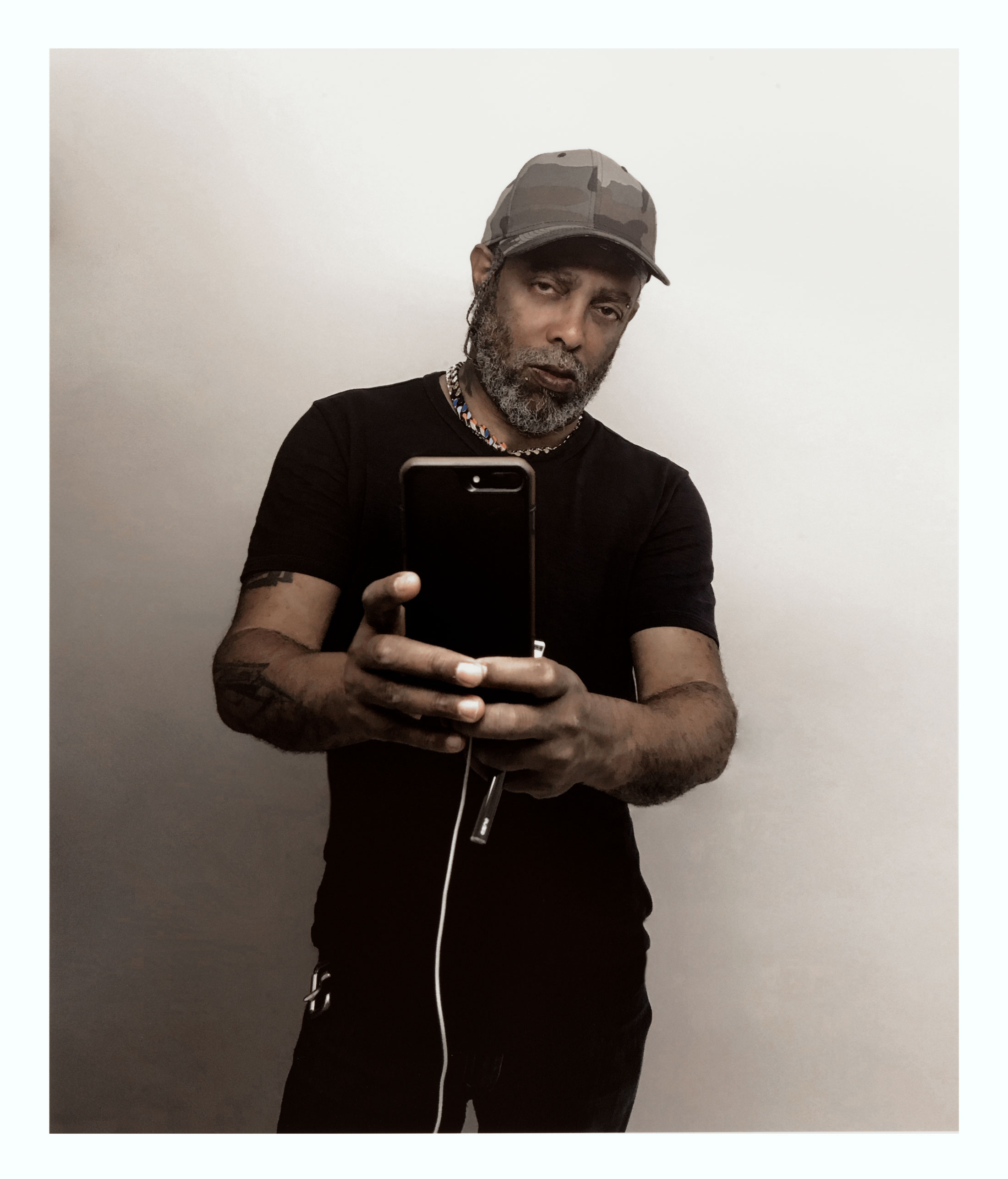
Arthur Jafa pulls up in his Tesla. The sun is good enough to squint at, and he fumbles a minute trying to lock the car—it’s new. In his large, spare studio, we swivel on mismatched chairs. While he sends off emails, pressed between meetings, his assistant and I talk warmly about interracial relationships and ancestral memory, the protests in Sudan, the dead in Sudan, American ambivalence. This is the type of casually polemical stuff that might snake into Jafa’s work; the type of conversations his work asks of us.
Since the early 1990s, Jafa’s career as a filmmaker and cinematographer has showcased incredible range and a tender, imaginative eye. Most famously, he was an early collaborator of Spike Lee’s (Crooklyn), and his work on Julie Dash’s 1991 film Daughters of the Dust won Best Cinematography at Sundance. He’s the lens behind the videos for Solange’s “Cranes in the Sky” and “Don’t Touch My Hair.”
But this is his time. The overwhelming success and praise of Jafa’s 2016 film Love is the Message, the Message is Death made him a star in the art world and brought international audiences and new acclaim for a role he’d already been playing. Since its premiere, Love is the Message, the Message is Death has been jointly acquired by the Smithsonian and the Hirshhorn, and Jafa recently scooped the Golden Lion award at the Venice Biennale— and the Tesla.
“Five years ago, I couldn’t point to work I felt was representative of me,” he says of his new status. While he’s proud of the films he’s worked on, he says, “that wasn’t my work.” “I’ve made big chunks of money at different points,” he offers. “Working with Spike here and there, but basically I’ve always worried about paying my rent. Until the last three years. Now all of a sudden, I have a Tesla, I got a studio, I got an assistant, somebody to work with, I’m very happy in my life.” And financial stability brings the opportunity to try new things. Ambitious and even risky things.
Love is the Message, the Message is Death renders a rich, sweeping portrait of Black American dynamism through the arrangement of found video and images: Biggie rapping on a Brooklyn corner before he was Biggie; President Obama singing “Amazing Grace”; Angela Davis wearing a slight grin; a church lady “catching the spirit,” all of it scored by Kanye West’s gospel-influenced “Ultralight Beam,” featuring then-newcomer Chance the Rapper. The film is brilliantly and achingly affecting.
“The fission, the fission, the fission,” he nods. “Particularly with something like Love is the Message, where the images are like the banks of a river, but what I’m really trying to mobilize is the energy between the images… Something that happens in the interstices, that’s the thing you’re actually trying to compose.” My poetry students might hear an echo of my sermons on word choice and line breaks—the artistic possibilities between lines, in the blank space, juxtaposition and double-speak. In Love is the Message, there’s energy in the splices between Jimi Hendrix and Stephen Curry; Aretha Franklin and Muhammad Ali. There’s an intentional choice to follow one image with another; a minstrel show before a clip of post-Black Michael Jackson shimmying in a backseat. With Jafa’s deft cinematographic eye and sharply attuned musicality, Drake’s dancing seems choreographed to “Ultralight Beam,” and Chance raps “now they wanna hit me with the woo wop da bam,” just as a policeman beats the hell out of a Black kid. It’s the artist’s choices that make the film an experience, rather than a compendium of one.

Jafa speaks energetically about the “great event horizon” of cinema, particularly the sprawling possibility for innovation in Black film. “How do you bring what I would term ‘poly-eventuality’ to film? How do you bring a kind of attentiveness and acute awareness to things happening in relation spatially and temporally?” How to tell the whole story, and several stories at once. “It’s a space in which I think Black people are built to excel.”
How do you create artworks as fluid and multidimensional as Blackness?
One concern and focus of Jafa’s work, he says, is possibility. “Keeping it real,” seeing a thing as it is, can invite change and “bring the thing into the space of actualization or emergence,” where something new can be imagined. His work is also, of course, all about the lens. “I’m trying to demonstrate the value of things that are not considered valued,” he says simply. “I’m also trying to demonstrate the possibility of creating the new. Emerging something else, provoking something else, creating new actualities.”
Jafa’s 2018 film The White Album is a lens on whiteness (not, he clarifies, white people). At 30 minutes, it’s quite a different look than Love is the Message, which is just over seven minutes. It’s quieter and the pace is much slower, with long close-ups of white men with beards and somber white women, and YouTube videos in their entirety. One video, a white teenage girl’s manifesto on reverse racism (because “it’s gotten to the point that it’s ridiculous”), includes such time-honored bops as “I’m the furthest thing from racist,” and “Some of my best friends are Black,” with a guest appearance by “I’ve had it hard, too.” One is a fervent, basically accurate, and thorough-for-a-white-guy speech about the evil of white supremacy, a call to his fellow whites to let go of their fear. One clip shows a white man glaring stone-faced into the camera, loading and unloading his stash of machine guns, handguns and rifles, each weapon pointed at the audience in succession. One way to describe The White Album is uneasy.
“Whiteness can only sustain itself by controlling the terms of interaction,” so Jafa’s confrontational investigation into whiteness and its psychology has all intention to make people, especially white people, uncomfortable. The film writes whiteness through images of goths dancing to rap under a bridge; dark, brooding shots of Robert Pattinson in Good Time; a white guy dancing to the undisputed white people anthem, Bon Jovi’s “Livin’ on a Prayer.” When Dylann Roof enters the Emanuel African Methodist Episcopal Church in Charleston, we hear Iggy Pop sing, “the purest act is love.” For 30 awkward minutes, we’re forced to simmer in the dichotomies, violence both naked and subtle.
“The very last shot added to Love is the Message, the Message is Death, was of a sister twerking.” Jafa tells me how some friends quickly said they were puzzled by his decision to include it, and so near the end of the film. “Because it was surrounded by these Olympian figures like LeBron and James Brown.” But for Jafa, it’s virtuosity. “It’s like they say: as above, so below.”
Jafa says there was never a question about beginning Love is the Message with Charles Ramsey’s renowned news interview, hilarious and incredible in its realness. “That’s what an actual hero looks like,” declares Jafa. “The humanity is so on point and so foregrounded.” In the clip, Ramsey laughs, “A little white girl came out and I knew something was wrong!”

“He’s not unaware of his status in the world,” Jafa comments. “And how much of an anomaly he is.” Part of the intention of Jafa’s films, much like hip hop sampling, is to amplify and point back to the source material. (“Making it louder, noisier, making it more dissonant, making it more rhythmic, making it more, more, more,” he emphasizes. “That’s what I mean by amplification.”)
He points out a moment in the original video when Ramsey stops in the middle of his story and leaves the frame to help the camera person with some equipment. “That is a very advanced person in terms of their empathy, compassion,” which he says is worthy of emulating.
In Interview, a few months after its release, Antwaun Sargent smartly described Love is the Message as “vividly and viscerally tracking the experience of being African American.” David Brooks, in the New York Times, called it “an intense compilation of the African American experience,” as if it were a highlight reel or graduation slideshow, and several reviews use similar language. What the verbiage of Sargent’s statement allows for is something critical to Jafa’s work: Movement. Aliveness. What is that thing, the African American experience, and why are we always trying to make it be still?










 in your life?
in your life?

